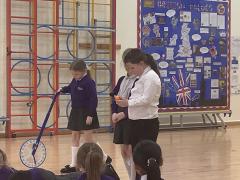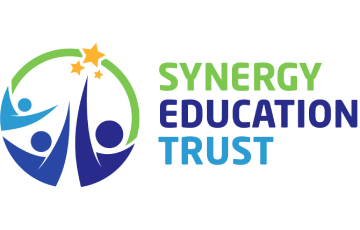Science: Blog items
Date: 10th Mar 2025 @ 8:33pm
This week, we looked at what happens to sounds the further away they get. We used the school hall and measured (using a sound meter) the sound (in decibels) of four different sources. We used a whistle, a drum, a whispered sentence and crumpling paper. Using a trundle wheel, we measured 5m, 10m, 15m and 18m. We found that the further away the sound got, the more quiet it became. This is because the sound energy starts to run out - this is called dissipation.
Date: 6th Mar 2025 @ 4:48pm
This week pupils in year 5 were investigating the force of friction. Using force metres, pupils measured the force rquired to move a 500g load up an inclined ramp made from different materials. We discussed how to make it a fair test by keeping certain variables the same: E.g. the people conducting the test, the weight of the load, the incline of the ramp and even the force of gravity! Pupils then discussed their findings and made conclusions about the smoothness of a material and the amount of friction that it creates.
Year 1 Polar and Desert Habitats
Date: 3rd Mar 2025 @ 7:52pm
Today we learnt about two habitats – a polar habitat and a desert habitat. We began by identifying the features of a polar habitat, watching a short video and looking at photos. We looked at the climate in a polar habitat, animals that live there and how they are suitable to their habitat. We then began to look at a desert habitat, again identifying the features by watching a short video and looking at photos. We then looked at a number of animals that live in the desert and learnt about how they are suited to that habitat. We then completed a desert and polar habitat sort with a partner, verbally discussing the reasons and explaining how we know which animals live where.
Date: 28th Feb 2025 @ 8:10am
Yesterday, we had our first forest school session of the Spring term. Whilst in the forest school area, we went searching for worms in the area as well as other bugs that were out there and discussed how the conditions were right for their survival.
Date: 27th Feb 2025 @ 8:53am
In Year 3, we have started our new Science topic of Light. In this lesson we looked at our key questions 'What is light?'. We looked at placing objects in a box and thinking about if we could see the objects inside. Slowly, we added more light and saw that we could see. From this we then looked at what produces light and what doesn't. We then looked at identifying, classifying and grouping light sources into natural and human made sources.
Date: 6th Feb 2025 @ 2:59pm
The children cooked up a real treat in the mud kithen this week! If apples, carrots, flowers and a dash of mud are your cup of tea then head over to the Nursery Mud Kitchen! The children worked hard chopping and mixing. It was wonderful to see them working together and sharing cutlery. There was a great discussion about the inside of an apple as they discovered a star shape where the pips had been and how we can grow apple trees from the pips.
Year 1 Carnivore, Herbivore, Omnivore
Date: 30th Jan 2025 @ 5:42pm
After recapping on the animals groups we have learnt about this half term, we discussed our question for today’s lesson. We talked about what we already know about what animals eat and learnt three new key words to describe animal diets. We tried very hard to use our new vocabulary when sorting animals according to their diets.
Date: 28th Jan 2025 @ 4:17pm
Today, we used our knowledge of simple circuits to predict whether a light bulb will light thinking about what was included in the circuit and the role they had.
Date: 28th Jan 2025 @ 3:40pm
This week in our Science we practised our oracy skills. We were given a concept cartoon and 'Challenge' stem sentences. First we practised our responses in a Nest then we did Pair work.
Date: 23rd Jan 2025 @ 2:41pm
Nursery explored a different way to paint when they were provided with blocks of ice, paint and paint brushes. We talked about the texture of the ice, how it was hard to paint on it because the ice was slippy and obserevd how the ice began to melt the more we painted on it. The children also enjoyed discovering what happened to the colours as they mixed together and water was added.
Date: 16th Jan 2025 @ 9:29am
Our Science topic this half term is about classification. We have learned why scientists classify living things into different groups. Last week we focused on classifying animals and this week we have looked at plants. We learned about flowering and non-flowering plants and different types of trees - deciduous and evergreen. We have discussed questions that we could ask to group animals and plants and created out own classification keys.
Date: 16th Jan 2025 @ 8:40am
This wee, we started our Science unit about Electricity. We spoke about what it is and we looked at appliances which use mains and battery.
Date: 14th Jan 2025 @ 9:15am
This week the pupils in year 5 began their science journey all about animals. In this lesson we talked about the human stages of life and pupils learned the meaning of gestation and life span. Pupils then drew a scatter graph plotting the gestation period against life span for certain animals. We discovered that larger animals had a longer life span and a longer gestation period compared to small animals.
Date: 13th Jan 2025 @ 4:49pm
Over the next few week the children are going to be learning about the season of Winter. We will be looking for for signs of winter in our outside area and making observations about what how the weather and temperature has changed. This week the children were lucky enough to enjoy the snow and take part in lots of wintery games outside including sledging down our hell and making snowmen.
"I|t might snow in Winter" Dennis
"The trees are bare and have no leaves" Lily-Mae
"It is every cold so you wear a hat and scarf" Aurora
Year 3- Identifying and classifying rocks!
Date: 10th Jan 2025 @ 3:53pm
In Year Three, we are beginning our new Science learning about Rocks. The children looked at a range of rocks to identify their qualities and discussed the different appearances. We discussed the three different rock types and made comparisons between them.
Nursery Make the Most of the Snow
Date: 9th Jan 2025 @ 2:44pm
Nursery had a wondeful time exploring the snow this week! We made sure we wrapped up warm and then went out to make snow angels and build mini snowmen. The children also had a great time sliding down the very slippery slide. Some of the snow began to melt and we talked about why it was starting to melt.
Year 3- Investigating insects!
Date: 12th Dec 2024 @ 9:25am
In Year 3, we have been looking at Animals including Humans. In this lesson we looked at a range of insects and explored if their leg and muscle size affected how far they could jump. We then compared how animals use their muscles to move, and compared the similarities and differences between them.
Date: 9th Dec 2024 @ 2:23pm
This week, we looked at food chains. We learnt the word Apex Predator which means the animal at the top of the food chain. We played an online game together putting cards in the correct position depending whether they were a producer, prey or predator. Then we had a go at it ourselves.
Date: 5th Dec 2024 @ 11:25am
As part of our PSHE and Science curriculum, today we invited PCSO Debby Savage to talk to Year 6 about the effects and dangers of drugs and alcohol. The children were very sensible listening to what she had to say and asked some very good questions. We discussed smoking, vaping, alcohol and illegal/legal drugs and how they can affect our bodies.
Year 5 - Excellent Evaporating
Date: 5th Dec 2024 @ 9:25am
This week pupils were given the task of seperating a saltwater solution. We reminded ourselves about what a solution is and how it is different to a mixture, and pupils identified salt as the solute and water as the solvent. Pupils completed an experiment where they heated the solution to evaporate the water. This left behind crystals of pure salt. In a discussion, pupils linked this to prior learning about the water-cycle.
Date: 5th Dec 2024 @ 9:11am
Year 6 have completed some great work in Science this half term. We have learned all about electricity including how to draw circuit symbols and circuit diagrams. We have worked scientifically and carried out an investigation into what happens to a bulb when you add more cells to the circuit. The children really enjoyed this topic and remembered lots of their learning when they did the end of unit assessments.
Reception- Boundary Learning Together
Date: 2nd Dec 2024 @ 12:16pm
Reception were asked to collect things they found when they went on an Autumn walk at home.
Lucas's BLT project was amazing so it was displayed outside Miss Moyes room for the whole school and visitors to see.
"We went on a walk and collected leaves, twigs and grass... I made this with Mummy" Lucas.
Date: 29th Nov 2024 @ 11:16am
This week Acorns have been exploring habitats. We have engaged in a variety of multisensory activities to develop our curiosity and understanding.
We have enjoyed our tuff tray of different environments, singing the habitat song and looking at the different animals and where they live.
Date: 27th Nov 2024 @ 12:49pm
Today we spent no pen morning building houses for the three little pigs! We listened to the story, talked about the different materials the pigs use and the pros and cons of each. We then collected different materials from around the classroom and our outdoor area to build our houses.
Date: 22nd Nov 2024 @ 10:56am
This week Acorns have been exploring night and day. We have enjoyed developing our understanding through songs and rhymes and visuals, exploring what we do at night and during the day. Some of us made choices about what we would like to do during the day.





































































































